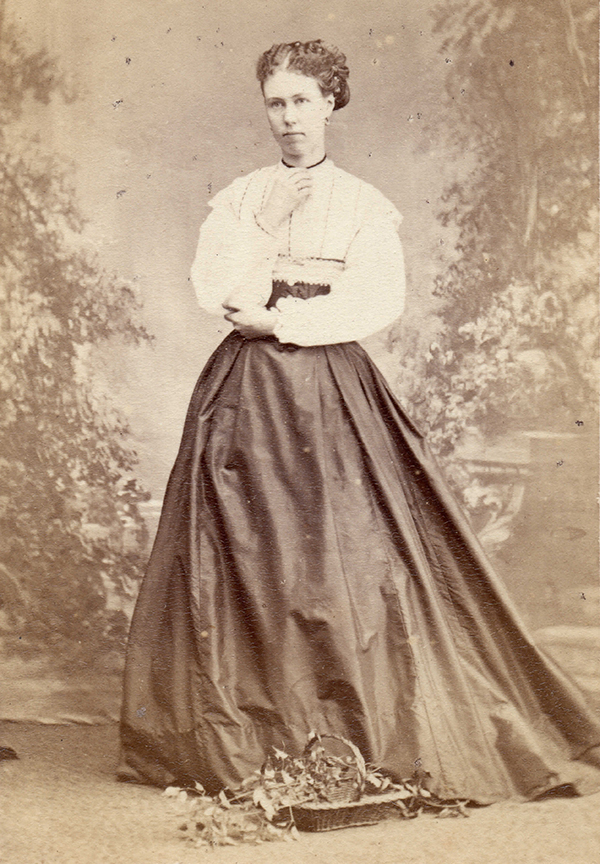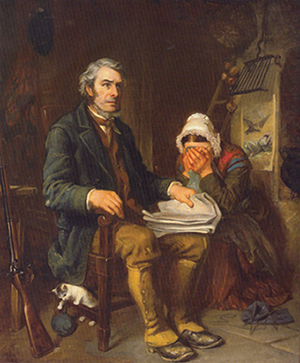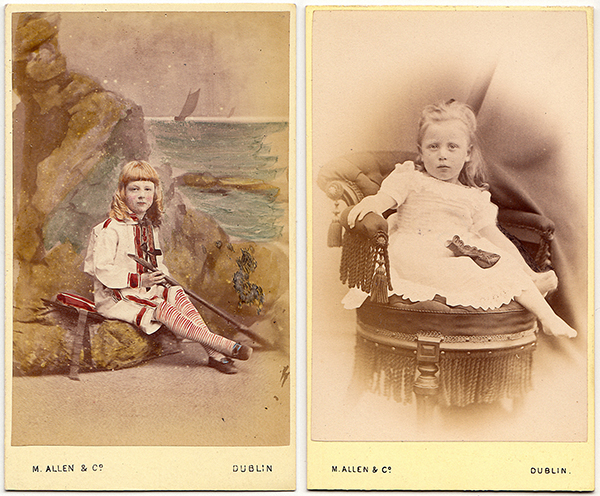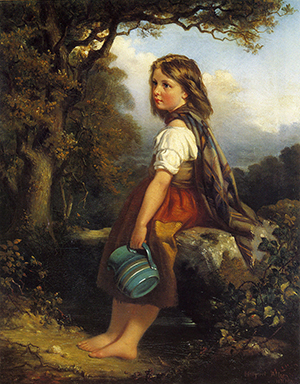UNFRAMING MARGARET ALLEN, HRHA (1832–1914)
Published in Features, Issue 2 (March/April 2022), Volume 30By Derville Murphy
Margaret Allen, the first female honorary member of the Royal Hibernian Academy (RHA), was an artist whose paintings were concerned with the social conditions of the time. What is less well known about her is that she was one of Dublin’s earliest female commercial photographers, whose work as an artist was enabled by photography and who used her artistic skills to embellish her photographic images.
M. ALLEN AND CO.
In 1860s Dublin there was a surge of interest in photography owing to technical developments that made photographs affordable for mass consumption. Initially costly, with long exposure times, the images were not easy to reproduce. In 1854, however, Parisian photographer André Disdéri (1819–89) developed a process that revolutionised production, whereby several photographs could be developed on paper using one glass plate. The photographs were small, measuring 2.25in. by 4in., and mounted on cardboard. Initially intended as calling cards, cartes de visite achieved widespread popularity and inspired the phenomenon known as ‘cartomania’. It became fashionable to collect albums of cartes of celebrities, actors, politicians and members of the aristocracy. This demand fuelled a surge in new commercial photographic studios in Dublin. Before 1860 there were twelve in the city but during the next decade 60 new studios opened for business. Amongst these was M. Allen and Co.
Mark Allen was a picture-framer and lithographic printer from a well-known Church of Ireland family who had lived and operated from 12 Westland Row since the mid-1840s. He had two daughters, Margaret and Harriet. By the 1860s Margaret, the eldest, had earned a reputation as a talented artist whose portraits were regularly accepted in the RHA summer exhibitions. Although details of her art education are unclear, the quality of her later paintings suggests that she had some academic training. She may have attended the Dublin School of Design or, like other women of her class, received private tuition. We do know that she studied in Paris, although for how long, or where, is uncertain. An advertisement in Saunders’s News-Letter (4 October 1861) advises that ‘Miss Allen, having returned from Paris, will reopen her Academy of Drawing and Painting … The Course of study will be the same as that in the Ateliers on the continent.’ She was giving lessons in drawing, oil painting and pastel, and she also provided ‘a draped model’ (Dublin Daily Express, 20 January 1862).
Mark Allen’s lithographic print business ceased around 1863—possibly because of his ill health—and, utilising Margaret’s expertise, M. Allen and Co. continued as an artists’ repository, hiring chromolithographic prints of famous works of art and selling artists’ supplies. Advertisements in Saunders’s News-Letter indicate that Margaret was running the business. In the Irish Times (14 March 1865), M. Allen and Co. announced that it was opening a photographic studio, providing cartes de visite in connection with its fine art repository. The company had secured the services of a French operator, ‘pupil of the celebrated Mr Ballor of Paris’. There was a commercial incentive for Margaret Allen to do this, as her income from painting portraits would have been threatened by the craze for photographic likenesses. The advent of carte de visites had democratised the ownership of portraiture, a luxury which previously only the wealthy could afford.
DEVELOPED AN INFORMAL STYLE
Four years later Mark Allen died, leaving Margaret as the family’s primary breadwinner. She continued to operate her drawing and painting academy, to run the business and to exhibit portraits, predominantly of children, annually at the RHA exhibitions. The fact that it was not considered respectable for middle-class women such as Margaret to engage in work outside the home likely influenced her decision to describe M. Allen and Co. in the Irish Times and Daily Advertiser (30 December 1869) as a ‘Studio for Children and Animals’:
‘Miss Allen pays particular attention to the photographing of Babies, and as the Waiting-room and Gallery are well heated, there is no danger of Infants or delicate children taking cold while being photographed.’
Looking at an example of one of the studio’s early photographs compared to later portraits of children, the informal style of the latter suggests that Margaret replaced the French operator’s initial stiff and conservative composition, which mimicked fine art’s full-length portrait, typical of early photography, with a more romantic style. This style typically used a soft focus, popularised by celebrated Victorian photographer Julia Cameron (1815–79), with whose work Allen would have been familiar.

Above: The formality of this 1865 Margaret Allen photograph of an unknown woman—mimicking a full-length fine art portrait—contrasts with the informality and romanticism of her 1877 portrait (above) of Sermonda Burrell. (M. Allen and Co.)
ART OR SCIENCE?
From its inception the practice of photography was difficult to classify, being generally considered to hover on the boundary between science and art. Some practitioners called themselves artist-photographers; others adopted the title of ‘professor’, reinforcing photography’s scientific credentials. At face value, photography appeared to transform the production of portraiture from an artistic process into a technical one. Nevertheless, despite the novelty of the printed image, an artist’s skill to enhance and to beautify was still considered desirable, and many photographers used artists to enhance their photographic images. For Allen there were obvious synergies between the two activities, using photographs as aides-mémoire for portraits and as a means of marketing these amongst her customers.
In an 1874 Irish Times advertisement she claims to provide ‘Enlargements painted in oils and watercolours’. By 1868 it was possible to project images onto photo-sensitised canvas and to use these as a base for watercolour, pastel or oil portraits—or to paint over photographic images pasted on canvas. Although there is no evidence of Allen doing this, it is likely that she used photographic enlargements on paper as drawing aids. Ultimately the popularisation of photographic portraits marked a move away from hyper-realism in portraiture to a more relaxed style that authenticated painterly credentials. This can be seen in Allen’s painting Listening to the Birds (1873) (above).
Allen used her skills as an artist to paint backdrops for photographs and to hand-tint images, both fashionable practices. She even created papier mâché rocks for sea scenes, as can be seen in this hand-coloured carte de visite of a young boy with distinctive red striped socks and boater hat (above). Unfortunately, the colours have deteriorated over time owing to the interaction between the paint and the chemicals used in the photographic process.
MIXED REACTION
Amongst the Irish artists’ community there was a mixed reaction to photography. Equestrian artist Michael Angelo Hayes RHA (1820–77) was a founder member of the Dublin Photographic Society in 1854. He, and others of a like mind, could see photography’s potential not only as an exciting new art form but also as an important tool for artists to explore visual properties, and as an aide-mémoire of people and places. For a middle-class female artist, however, photography held other attractions. It encouraged Allen to consider subject-matter beyond the physical confines of her studio and to transform her single portraits into works that could be considered genre paintings.
Fashionable in Ireland from the 1850s, genre painting was inspired by the work of French artists Gustave Courbet (1819–77) and Jean-François Millet (1814–75), who wished to paint actual people carrying out everyday activities in real locations (as opposed to the classical, stylised, historical ideals of academic art). For a middle-class woman like Allen these aspirations were impracticable. It would have been considered unacceptable for her to travel the countryside to engage in observational life-sketching of country folk, as her male peers could do. Allen’s models were, of necessity, closer to home, probably her family or servants.
THE LAST HOUR IN THE OLD LAND
Allen’s most accomplished work, The Last Hour in the Old Land (1876), shows how her knowledge of photography influenced the painting’s execution (front cover). It shows a couple, tired and dejected, sitting on the quays with their scant belongings around them. Behind them a theatre bill ironically advertises The Eviction, ‘a great success’, ironically highlighting the British government’s failure to put in place effective measures to alleviate the suffering caused by the Great Famine. The work follows a tradition of painting in Ireland, dating from the early decades of the nineteenth century, that could be described as realist, although much of it was romantic. A contemporary of Allen’s whose work was clearly an influence was James Brenan RHA (1837–1907). Although the subject-matter of his paintings was often sentimentalised, he consistently strove to achieve realism.
Making preparatory sketches on the city quays for this painting would not have been possible for a woman of Allen’s class. Instead, she used her skills as a photographer to create the scene. Consequently, the painting has some of the qualities of a photographer’s set—there is no real spatial quality to the work. The suggestion of ships at the quays could almost be one of her painted backdrops, possibly copied from a photograph. The figures posed in front, although well executed, do not appear grounded; they could be easily transposed to some other scenario. She also uses accessories—the shawl, the jug, and even the posters—as props, in the same way as a photographer.
Despite these limitations, however, Allen manages to project into the composition a poignant and romantic informality that can be seen in her photographs of children of the period. Possibly as a result of positive acclaim for this work—at a time when art was considered an acceptable hobby for a respectable woman, but not as a serious pursuit—in 1878 Allen was awarded honorary status at the RHA, the first woman to be so recognised.
Margaret’s sister Harriet married Edward Williams, a trainee dentist, in 1873 and the couple moved to Manchester. After the death of her sister’s first child, Margaret travelled between the two cities to support her sister while still managing the photographic business in Dublin. Once Edward qualified as a dentist in 1881, however, the upper floors in Westland Row were rented out. By 1883 Margaret was living with her sister and brother-in-law and working as a portrait-painter in Manchester, and by the following year M. Allen and Co. had closed for business.
BAD NEWS IN TROUBLED TIMES

Above: Bad news in troubled times: ‘An important arrest has been made of a young man named —’, 1886. (Quinnipiac University)
While living in Manchester, Allen painted Bad news in troubled times: ‘An important arrest has been made of a young man named —’, depicting a man reading a newspaper and learning of his son’s arrest following illegal Fenian activity (right). His distraught wife sits weeping beside him. This painting and The Last Hour reflect Allen’s nationalist sympathies and were brave subjects for a female artist at the time, demonstrating remarkable moral courage. Victorian England did not value women who held political opinions, let alone displayed them. These works were unlikely to please her patrons, for whom she supplied a steady stream of portraits and charming genre scenes.
Allen was not welcomed into the fold of the thriving Manchester art scene, nor was she a member of the Manchester Society of Women Painters, founded in 1879 by Annie Swynnerton (1844–1933) and Susan Isabel Dacre (1844–1933). Was it because she was too strident in her nationalist views?
Adverse reaction to Bad news in troubled times could account for the fact that subsequently she submitted portraits and genre scenes to the RHA annual exhibition with uncontroversial titles such as The Sick Doll (1887), also shown at the 1888 Manchester exhibition, and At evening time it shall be light (1890). During this period she also showed works at the Walker Art Gallery, Liverpool, and with the Royal Society of Artists, Birmingham. Allen submitted her last painting to the RHA, Mother’s Darling, in 1894, aged 62. Following her sister Harriet’s death in 1903 she returned to live in Dublin. She died in Brookville House at Balleen, Co. Kilkenny, on 26 March 1914.
Margaret Allen achieved significant recognition as an artist in Ireland, although her move to Britain to support her family ultimately proved detrimental to her career. Despite limitations in her education, and the constraints of her gender and class, she succeeded in producing work that, in its social commentary, was political at a time when critical commentary even by male artists was unusual. It was Margaret Allen’s practice as a photographer, however, that enabled her to achieve these distinctions, and certainly helped her to overcome some of the difficulties faced at that time by other female painters of her class.
Derville Murphy is an architect, artist, art and architectural historian, and author of If she only knew (Poolbeg Press, 2021), a historical novel inspired by the life and times of Margaret Allen.
Further reading
E. Chandler, Photography in Ireland—the nineteenth century (Dublin, 2001).
O. Fitzpatrick, Jacolette: a gallery of Irish snapshot and vernacular photography (https://jacolette.wordpress.com/).
D. Murphy, ‘Margaret Allen—social commentator’, The Irish Arts Review (Spring 2010).


















